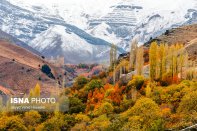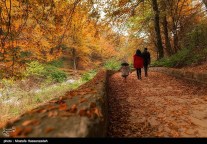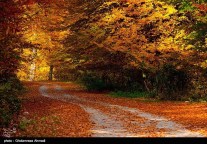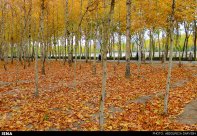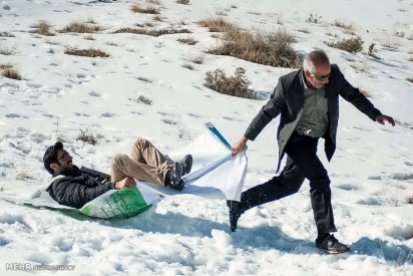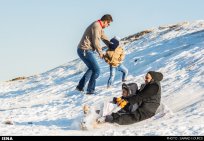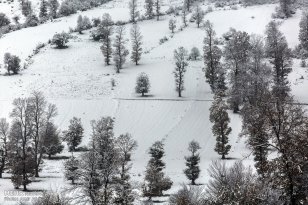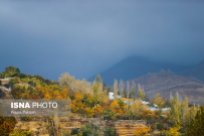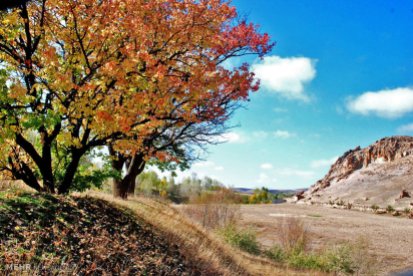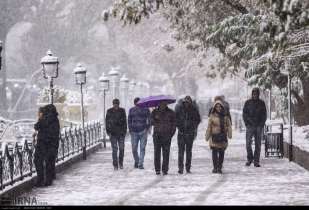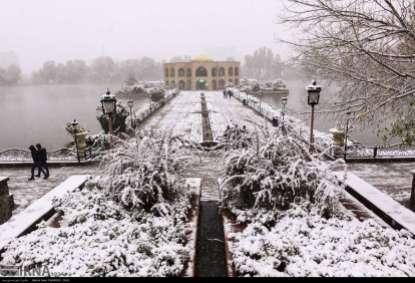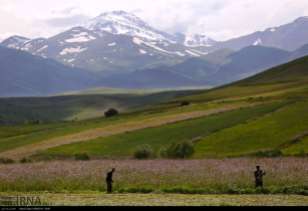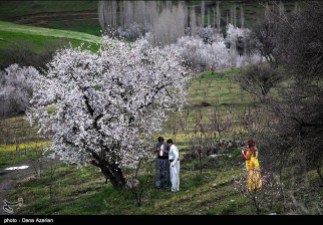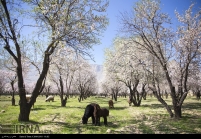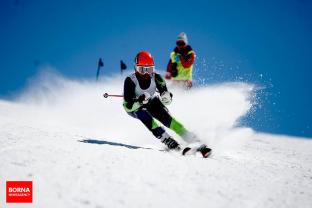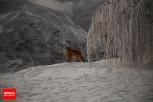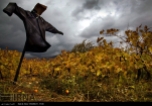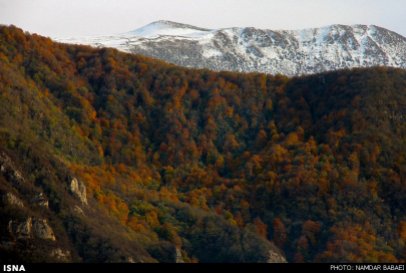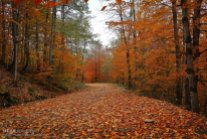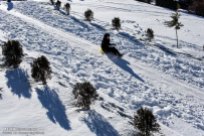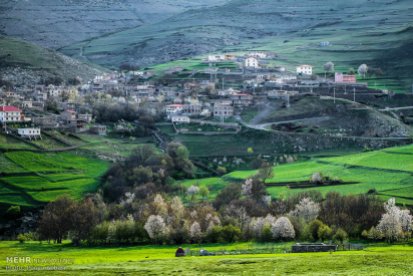Sources: ISNA I, ISNA II, ISNA III, IRNA I, IRNA II, IRNA III, Tasnim News Agency (TNA) I, TNA II, TNA III, TNA IV, TNA V, TNA VI, TNA VII, TNA VIII, TNA IX, Azad News Agency, Mehr News Agency (MNA) I, MNA II, MNA III, MNA IV, MNA V, asangardi.com, Fars News Agency
Tag Archives: Provinces of Iran
Photo Series: Autumn in Iran – Isfahan
Isfahan was once one of the largest cities in the world. It flourished from 1050 to 1722, particularly in the 16th century under the Safavid dynasty. Even today, the city retains much of its past glory. It is famous for its Persian–Islamic architecture, with many beautiful boulevards, covered bridges, palaces, mosques, and minarets. This led to the Persian proverb “Esfahān nesf-e- jahān ast” (Isfahan is half of the world).
The Naghsh-e Jahan Square in Isfahan is one of the largest city squares in the world and an outstanding example of Iranian and Islamic architecture. It has been designated by UNESCO as a World Heritage Site. The city also has a wide variety of historic monuments and is known for the paintings, history and architecture.
Photo gallery: Beautiful pictures of Isfahan in autumn
Today Isfahan is the capital of Isfahan Province and with a population of 1,755,382 inhabitants is also Iran’s third largest city after Tehran and Mashhad. The city is located 340 kilometres south of Tehran, in the lush plain of the Zayanderud River, at the foothills of the Zagros mountain range.
The nearest mountain is Mount Soffeh (Kuh-e Soffeh) which is situated just south of Isfahan, at 1,590 metres (5,217 ft) above sea level on the eastern side of the Zagros Mountains. Isfahan has an arid climate but despite its altitude, the city remains hot during the summer. However, with low humidity and moderate temperatures at night, the climate can be very pleasant.
Source: Wikipedia | Isfahan, ISNA I, ISNA II, ISNA III, Borna News I, Borna News II
Photo series: Winter in Iran – Snow sliding
Autumn snow in northern and central Iran (Photos)
Photo Series: Autumn in Iran – Hamedan Province (Part 3)
Hamedan Province is one of the most ancient regions of Iran. The city of Hamedan laid on the Silk Road. The Province lies on the Zagros mountain range. Hamedan enjoys temperate warm summers and relatively cold winters.
According to local Jewish traditions, Hamedan is mentioned in the Book of Esther as the capital of Ancient Persia in the days of King Ahasuerus. It was then known as Shushan. The Tombs of Mordecai and Esther are located in modern-day Hamedan.
Related articles:
– The other Iran | Autumn in Iran
– The other Iran | Hamedan Province
Sources: Mehr News 1, ISNA 1, ISNA 2, Tasnim News, Wikipedia | Hamedan, Mehr News 2
Photo Series: Autumn in Iran – Arasbaran
Arasbaran is a mountainous area in the north of East Azerbaijan Province in northwest of Iran. This region is famous for the unique and intact nature. Since 1976 UNESCO has registered 72.460 hectares of Arasbaran as biosphere reserve. Enjoy the photo gallery!
Other Arasbaran photo galleries: The other Iran | Arasbaran
More information about Arasbaran: The other Iran | Spring in Arasbaran
Sources: ISNA, Mehr News Agency, Wikipedia | Arasbaran
Photo series: Autumn in Iran – First snow in Tabriz
Tabriz, capital of East Azerbaijan Province, is one of the most populous cities in Iran. Located at 1,350 meters above sea level, it has cold winters and mild summers.
As one of the historical capitals of Iran, the city has a long and turbulent history. Its oldest civilization sites date back to 1,500 B.C. The transition of the different Iranian architecture styles is still visible on its buildings although repeated devastating earthquakes and several invasions have damaged many of its historical monuments. The Tabriz Historic Bazaar Complex was inscribed as a World Heritage Site in 2010.
Sources: IRNA, Young Journalists Club, Fars News Agency, Wikipedia | Tabriz
Photo Series: Autumn in Iran – Mashhad
Mashhad is the second most populous city in Iran and is the capital of Razavi Khorasan Province. It is located in the north east of the country close to the borders of Afghanistan and Turkmenistan. Its population is 3,131,586. It was a major oasis along the ancient Silk Road connecting with Merv in the East.
Mashhad is also known as the city of Ferdowsi, the Iranian poet of Shahnameh, which is considered to be the national epic of Iran. The city is also well-known and respected for housing the tomb of Imam Reza, the eighth Shia Imam.
Sources: Tasnim News, Wikipedia | Mashhad
Jangal-e Abr: Beautiful cloud forest in northern Iran (Photos)
Jangal-e Abr (Cloud Forest or Cloud Jungle) is one of the oldest and most beautiful forests in Iran. It is located on the eastern part of Alborz mountains, on the border between the provinces of Semnan and Golestan, 45km north east of Shahrud.
Sprawling on an area of 35,000 hectares, the Cloud Forest is a remnant of the ancient Caspian and Hyrcanian forests, encircling the northern slopes of the Alborz Mountains like a belt, covering the southern coasts of the Caspian Sea. Inside the thick woods, it is hard to imagine that the forest is located in the semi-arid province of Semnan, close to the Central Desert and Khar-Turan National Park.
When the temperature falls, two or three hours before sunset, clouds rush into the forest. They are so thick that you may not see an arm lenght in front of you. Above them Ghale Maran, a peak of high altitude, seems to be floating on the sea of clouds. It is said that there was ancient castle located on top of this mountain, south of Ramian. After a while into the night, the clouds usually scatter away, letting a clear view of the surrounding valleys, if the moon is up.
Sources: ISNA 1, ISNA 2, irpedia.com, financialtribune.com, tishineh.com, iranlandmark.ir, instagram @chamgir, instagram @yasin_0500, instagram @sshnzk, instagram @arsalanpartovi, anobanini.com, Wikipedia | Jangal-e Abr (in Persian)
Photo Series: Spring in Iran – Ardabil Province
The province of Ardabil is located in the north-west of Iran, bordering the Republic of Azerbaijan and the provinces of East Azarbaijan, Zanjan and Gilan. The Talesh mountain range on the east separates Ardabil from Gilan. The majority of its population are Azeris.
The origins of the city Ardabil go back 4000 to 6000 years, but its golden age was in the Safavid period. The name of Ardabil came from a Zoroastrian name of “Artavil” (mentioned in Avesta) which means a holy place. Meshgin Shahr, called “Khiav”, “Orami”, and “Varavi” in the past, is the closest city to the Sabalan mountains.
Sabaland, an inactive volcano in the Alborz mountains, is Ardabil’s most famous natural region but the province offers many other beautiful natural landscapes, mineral and hot springs (Sareyn, Khalkhal, Sardabeh, Booshli) and lakes (Neor, Shoorabil, Shoorgel, Noushahr, Alooche).
The weather in the province varies drastically. The city of Ardabil has very cold winters (-23°C) and very pleasant summers. Bilasuar and Parsabad have hot summers and warm winters. But generally this province is considered the coldest province in Iran though large parts of the province are green and forested.
Other nature posts: The other Iran | Nature
Sources: Iran Chamber Society, Wikipedia | Ardabil Province, IRNA 1, IRNA 2, Tasnim News Agency (TNA) 1, TNA 2, ISNA
Photo Series: Spring in Iran – North Khorasan Province
North Khorasan Province, located in northeastern Iran with Bojnord as its capital, is one of the most multicultural territories in the country: Kurdish speakers make a 46.1% of the population, followed by Persian speakers (27.8%), Khorasani Turks (20.6%), Turkmens (3.3%) and other Iranians (2.2%).
Photos: Early spring days across North Khorasan Province (Borna)
Sources: Wikipedia | North Khorasan, Borna News Agency
Iran’s Tehran Province: Park-e Shahr in Tehran
Park-e Shahr, literally the City Park, is one of the oldest parks in Tehran, located just a few blocks north of the Grand Bazaar. The park covers over 25 hectares and, besides its 17.3 hectares dedicated to green space, it houses a lake, a library, a small aviary garden and a traditional restaurant.
The Tehran Peace Museum, a member of the International Network of Museums for Peace, is also located within Park-e Shahr. The main objective of the museum is to promote a culture of peace through raising awareness about the devastating consequences of war. The museum coordinates a peace education program that holds workshops on humanitarian law, disarmament, tolerance, and peace education.
Sources: Wikipedia | Park-e Shahr, The Culture Trip, Untold Iran, Tehran Picture Agency (TPA) 1, TPA 2, Wikipedia | Tehran Peace Museum
Photos: Sand sculptures in Kish Island, Iran
Kish is a duty-free, resort island in the Persian Gulf 19 kilometers from mainland Iran, in Hormozgan Province. It has a population of 26,000 residents and about 1 million visitors annually. The island is located on a narrow strip of tropical vegetation in the Northern Hemisphere and has a semi-equatorial climate. Along its coast are coral reefs and many other small islands.
Sources: kish.ir, Tasnim News Agency, Mehr News Agency, Wikipedia | Kish Island
Photo Series: Spring in Iran – Marivan, Kurdistan Province
Marivan is a city on the Zagros mountain range, in Kurdistan Province, western Iran. West from the city, to the feet of high mountains and surrounded by thick forests lies Lake Zarivar.
Related articles: The other Iran | Landscape
Photos: Early spring days in Marivan, Kurdistan Province, Iran
Sources: Mehr News Agency, Wikipedia | Marivan, Wikipedia | Kurdistan Province
Photo series: Winter in Iran – First spring signs
Nowruz, the Iranian New Year celebrated on the day of the spring equinox in the northern hemisphere, has almost arrived and with it we can enjoy the first blossoms across the country: From Rumeshgan in Lorestan, Estur in Kerman, Khaledah and Shiraz in Fars to the gardens of Qazvin.
Sources: Mehr News Agency (MNA) 1, MNA 2, MNA 3, MNA 4, Tasnim News Agency, ISNA, IRNA, Jamejam Online
Photo series: Winter in Iran – Youth Alpine Ski Championship in Tehran
Tochal Ski complex hosted a competition attended by more than eighty young athletes.
Other winter photo galleries: The other Iran | Winter
Sources: Borna News Agency, Sport Tehran
Photo series: Winter in Iran – Savadkuh County, Mazandaran
The Veresk Bridge and the Three Golden Lines, a railway spiral passing three times by the same area at different heights are located in Savadkuh County, Mazandaran Province. They are part of the Trans-Iranian Railway, a major railway building project that started in 1927 and completed in 1938. It links the capital Tehran with the Persian Gulf and Caspian Sea.
The Danish firm Kampsax began constructing Veresk Bridge in 1934. The structure stands at 110m height and has a 66m long arch. It connects two mountains in the Abbas Abad region.
The construction of this bridge included craftsmen of many nationalities. The name of the bridge is derived from the name of a Czechoslovakian technician whose name was hard to pronounce for Iranians. Near the bridge is a memorial for the workers who lost their life while building the bridge and its nearby tunnels. The Chief Engineer, Austrian Walter Aigner, following his wishes, is buried in the local cemetery of Veresk.
During World War II, it was known as the Pol-e-Piroozi, or the bridge of victory. During the course of the war, Reza Shah was asked by Hitler to blow up all tunnels and bridges, including the Veresk Bridge, on Iran’s railway lines in order to delay the transfer of goods and reinforcement troops to the north for the Russians. He furthermore promised to replace and reconstruct all of such demolished structures following the Germans’ victory in the war. Reza Shah rejected the request. Today trains connecting Tehran to Gorgan or Sari pass over this bridge an average of four times a day.
Sources: Wikipedia | Veresk Bridge, Borna News, highestbridges.com, fouman.com, Wikipedia | Trans-Iranian-Railway
Photo series: Winter in Iran – Enjoying the snow in Sepidan, Fars Province
Sepidan, which means “The Whiteland” in Persian, is a County located in the Zagros Mountains, in Iran’s Fars Province.
The beauty of the region – Sheshpir Lake, vineyards, forests and rivers – coupled with the mild climate in the summer makes Sepidan a popular destination for ecotourism. Roanj and Barmefirooz, 3.720 and 3.706 meters above sea level, are the highest peaks of the county and are covered with snow throughout the year. Margoon Waterfall, Beheshte Gomshodeh (Lost Paradise) and Pooladkaf, one of the best ski resorts in south Iran are at the foothills of these peaks.
Though Sepidan is visited mostly for its nature and landscapes, it can be a destination for historical and archeological tourists. Anshan, which is considered the Cradle of the Achaemenid Empire and Golbahar Tower, built by the Safavids are located also in this county.
Sources: Borna News, ISNA 1, Wikipedia | Sepidan (in French), Wiki Voyage | Sepidan
Iran’s Kermanshah Province: Kambadn
Kambadn was an ancient city, located north of ancient Kermanshah. Nowadays, with the expansion of the city the ruins are located between Taq Bostan and Kermanshah. A city named Kambadn was mentioned in Bisutun (Behistun), the inscriptions authored by Darius the Great, and archeological excavations have located this city near Taq Bostan.
Kermanshah is considered one of the cradles of prehistoric cultures. The area has been occupied by prehistoric people since the Lower Paleolithic period, and continued to later Paleolithic periods till late Pleistocene period; with Neanderthal presence in Middle Paleolithic. The region was also one of the first places in which human settlements were established between 8,000-10,000 years ago.
In May 2009 one of the oldest prehistorian village in the Middle East dating back to 9800 BCE, was discovered in Sahneh, located west of Kermanshah. Remains of later village occupations and early Bronze Age are found in a number of mound sites in the city itself.
In ancient Iranian mythology, the construction of the city is attributed to Tahmuras, the third king of Pishdadian dynasty. It is believed that the Sassanids have constructed Kermanshah and Bahram IV – he was called Kermanshah, meaning king of Kerman – gave his name to the city.
Source: IRNA, Wikipedia | Kambadn (Persian), Wikipedia | Kermanshah, amitisiran.blogfa.com
Photo series: Autumn in Iran – Danesfahan, Qazvin Province
Danesfahan is a city of around 9,000 inhabitants (2006) in Buin Zahra County, Qazvin Province, Iran. It is located west of Sagezabad and south of Esfarvarin. Historically, the city has been affected by earthquakes.
Photo gallery: Charming autumn nature in Danesfahan
Sources: Wikipedia | Danesfahan, Mehr News 1, Mehr News 2
Photo Series: Autumn in Iran – Gilan Province
Gilan Province lies along the Caspian Sea, bordering the Republic of Azerbaijan in the north, as well as Russia across the Caspian Sea. The climate is humid subtropical with the heaviest rainfall in Iran. Rasht, the capital of the province, is known within Iran as the “City of Rain”.
Large parts of the province are mountainous, green and forested. The coastal plain along the Caspian Sea is similar to that of Mazandaran, mainly used for rice paddies.
In May 1990 large parts of the province were destroyed by a huge earthquake, in which about 45,000 people died. Abbas Kiarostami made his films Life, and Nothing More… and Through the Olive Trees based upon this event.
Enjoy Gilan’s beauty in autumn:
Photo gallery: Zereshk (barberry) farms in Iran
Berberis vulgaris, also known as European barberry or simply Barberry, is a deciduous shrub, native to central and southern Europe, northwest Africa and western Asia. It grows up to 4m high with yellow flowers that bloom in late spring. The fruit is an oblong red berry, rich in Vitamin C, that ripens in late summer or autumn. Although it has a sharp flavor, people in many countries eat it as a tart and refreshing fruit. The thorny shrubs make harvesting them difficult, so in most places, they are not widely consumed. They are an important food for many small birds, which disperse the seeds in their droppings.
Iran is the largest producer of zereshk and saffron in the world. Zereshk (or sereshk) is the Persian name for the dried fruit of Berberis, specially that of Berberis integerrima ‘Bidaneh’, which is widely cultivated in Iran. Zereshk and saffron are produced on the same land and the harvest is at the same time. In Iran their main production area lies in South Khorasan, especially around Qaen and Birjand. There is evidence of cultivation of seedless barberry in South Khorasan two hundred years ago.
Zereshk is widely used in cooking, imparting a tart flavor to chicken dishes. It is usually cooked with rice, called zereshk polo, and provides a nice meal with chicken. Zereshk jam, zereshk juice, and zereshk fruit rolls are also produced in Iran.
Photos of zereshk farms in Semirom (Isfahan), Birjand and Zohan (South Khorasan)
Sources: Wikipedia | Berberis vulgaris, Mehr News 1, Mehr News 2, ISNA, IRNA
Photo Series: Autumn in Iran – Mazandaran Province
Mazandaran is a Caspian province in the north of Iran. Located on the southern coast of the Caspian Sea, it is bordered clockwise by Russia (across the sea), Golestan, Semnan, Tehran, Alborz, Qazvin, and Gilan provinces. Sari is the largest city and the capital of Mazandaran province.
The diverse nature of the province features plains, prairies, forests and rainforest stretching from the sandy beaches of the Caspian Sea to the rugged and snowcapped Alborz sierra, including Mount Damavand, one of the highest peaks and volcanos in Asia.
Sources: ISNA 1, ISNA 2, Wikipedia | Mazandaran Province
Photo Series: Autumn in Iran – Asalem to Khalkhal road
Khalkhal is the capital of Khalkhal County, in Ardabil Province, Iran. Its population is 38.521 (2006). Asalem is a city in Talesh County, Gilan Province, Iran. Its population is 3.347 (2006).
The road from Asalem to Khalkhal is known for its beautiful landscapes.
Sources: Wikipedia | Asalem, Wikipedia | Khalkhal, Tasnim News Agency, Mehr News, JameJam
Photo series: Autumn in Iran – Snow in Tabriz
Tabriz, located at an elevation of 1,350 meters above sea level, is the capital of East Azerbaijan Province and the most populated city North-Western Iran. With cold winters and temperate summers, the city is considered a summer resort.
Photo gallery: Tabriz covered in early autumn snow
Related content: The other Iran | Tabriz, The other Iran | East Azerbaijan Province
Sources: JameJam Online, Tasnim News Agency, Mehr News 1, Mehr News 2, Wikipedia | Tabriz
Photo gallery: Ski season started at Tochal Ski Resort in Tehran, Iran
Tochal ski resort officially started this year’s autumn-winter season.
Tochal Complex, located on the northernmost part of Tehran, has been open to the public since 1978. The gondola lift, used for accessing ski resorts and other recreational centres on the mountain, has a length of 7500m. It starts at the Velenjak valley at an altitude of 1900m and ends at Station 7, at an altitude of 3740m, near the main ridge of Mount Tochal. The main ski slopes are located in Station 7 and due to its height they are covered with snow for more than 8 months of the year.
Tochal Mountain offers an unexpected array of outdoors activities –from hiking to skiing and is seen as one of the perfect places to escape the commotion of the city that lies below it; Tehran. There are various mountaineering routes across the rugged landscape, which cater to different levels of ability (and enthusiasm).
Sources: IRNA, ISNA, BORNA, Mehr News, Fars News, Young Journalists Club, Tehran Times (PDF), Wikipedia | Tochal Complex
Photo Series: Autumn in Iran – A rainy day in Tehran
Iran’s capital, Tehran, with a population of around 9 million in the city and 16 million in the wider metropolitan area, is the largest city and urban area of Iran. The semi-arid climate of the city is largely defined by its geographic location, with the towering Alborz Mountains to its north and the central desert to the south. The weather is mild in spring and autumn, hot and dry in summer, and cold in winter. Because the city is large with significant differences in elevation among various districts, the weather is often cooler in the hilly north than in the flat southern part of Tehran.
Photo gallery: A rainy autumn day in Tehran’s Mellat Park
Source: ISNA, Fars News, IRNA, Tasnim News, Wikipedia | Tehran
Photo Series: Spring in Iran – Kaleybar, East Azerbaijan
Kaleybar is a city of 9.030 inhabitants (2006) in East Azerbaijan Province, Iran. This county produces beautiful pomegranates, excellent figs and grapes that are dried on fires (because the sun is always obscured by thick clouds). In recent year the city has become a tourist destination thanks to its proximity to Babak Castle.
History
Kaleybar was the stronghold of Babak Khorramdin who in 816 AD revolted against the Arabs. Babak’s resistance was ended in 836 when he was defeated by the Iranian General Afshin. This events got the town into the reports of early Islamic historians.
Language
The spoken language in Kaleybar is the Azeri dialect of Turkish. The name Kaleybar could have Tati origins, meaning a town built on rocks. The Kaleybar region with mountainous terrain, shepherding and cultivation of hillside possess the isolating features for the development of a sophisticated whistled language. The majority of males are able, and perhaps addicted, to masterfully mimic the melodic sounds of musical instruments using fingerless whistle. Melodic whistling, indeed, appears to be a private version of the Ashug music for personal satisfaction.
Ashugh music
The mountainous region of Qaradagh, due to its remoteness and inaccessibility, was a guardian of Ashugh music. This frequent allusions of this music to mountains, with the intention of arousing an emotional state with a tone of mild melancholy, is consistent with the geography of Kaleybar.
Aşıq Hoseyn Javan, born in Oti Kandi near Kaleybar, is a legendary Ashik. Hoseyn Javan’s music emphasizes on realism and beauties of real life in line with the mainstream world view of Arasbaran culture.
Surroundings
The locals cherish the landscape of their town mingled with the vivid yellow blossoming zoghal (cornelian cherry) trees in early spring. The berries will be sun-dried on flat roof tops and sold to the market as an ingredient of ash reshteh. Unfortunately, the local version of this thick soup is not offered in restaurants. In recent years, the regional government has organized zoghal festivals as a means of promoting tourism.
The relatively well preserved Babak Castle at an altitude of 2300m is located some 3km away from Kaleybar. This Sassanid era fortress is named after the ninth century Iranian resistance leader, Babak Khorramdin, who resisted Arab armies until year 839.
The mountain ranges south-west of Kaleybar are still used as summer camp of pastoralists belonging to Arasbaran Tribes. This provides an opportunity for observing the relaxed idyllic life style of bygone times. They generally welcome visitors as long as their cultures and mode of life is not ridiculed. The visit should be on sunny days when the shepherd dogs feel lethargic.
Further links:
Iran’s Razavi Khorasan Province: Mashhad’s Spring Flower Festival (Photos)
Each year, the city of Mashhad celebrates spring with a Flower Festival. More than eight million bulbous flowers (e.g. tulips) are being planted in parks and streets and can be enjoyed until mid-May.
 Mashhad (Persian: مشهد) with 3.150.000 inhabitants is the second most populous city in Iran and capital of Razavi Khorasan Province. It is located in the northeast of the country, close to the borders of Turkmenistan and Afghanistan. It was a major oasis along the ancient Silk Road connecting with Merv in the East.
Mashhad (Persian: مشهد) with 3.150.000 inhabitants is the second most populous city in Iran and capital of Razavi Khorasan Province. It is located in the northeast of the country, close to the borders of Turkmenistan and Afghanistan. It was a major oasis along the ancient Silk Road connecting with Merv in the East.
Every year, millions of pilgrims visit the Imam Reza shrine. Mashhad is also known as the city of Ferdowsi, the Iranian poet of Shahnameh, which is considered to be the national epic of Iran.
The city is located in the valley of the Kashaf River near Turkmenistan, between the two mountain ranges of Binalood and Hezar-masjed. The city benefits from the proximity of the mountains, having cool winters, pleasant springs, mild summers, and beautiful autumns. It is only about 250km (160 mi) away from Ashgabat, Turkmenistan.
Long a center of secular and religious learning, Mashhad has been a center for the arts and for the sciences. The Ferdowsi University of Mashhad, the Madrassa of Ayatollah Al-Khoei, originally built in the seventeenth century, and the Razavi University of Islamic Sciences, founded in 1984, are located here.
Mashhad is also home to one of the oldest libraries of the Middle-East with a history of over six centuries. The Astan-e Quds Razavi Museum, which is part of the Astan-e Quds Razavi Complex, is home to over 70,000 rare manuscripts from various historical eras. There are some six million historical documents in the foundation’s central library.
Apart from Imam Reza shrine, there are a number of large parks, the tombs of historical celebrities in nearby Tus and Nishapur, the tomb of Nadir Shah, Kooh Sangi park and the Koohestan Park-e-Shadi Complex.
Some points of interest lie outside the city: the tomb of Khajeh Morad, the tomb of Khajeh Rabi’ where there are some inscriptions by the renowned Safavid calligrapher Reza Abbasi and the tomb of Khajeh Abasalt. In Tus, 24km away from Mashhad, is the tomb of Ferdowsi. The summer resorts at Torghabeh, Torogh, Akhlamad, Zoshk and Shandiz are also nearby.
The Shah Public Bath, built during the Safavid era in 1648, is an outstanding example of the architecture of that period. It was recently restored, and is to be turned into a museum.
Other articles about Razavi Khorasan Province: The other Iran | Razavi Khorasan Province
Sources: IRNA | Photos, Wikipedia | Mashhad, Tasnim News Agency | Photos
Iran’s Ancient City Nishapur in Razavi Khorasan Province
Nishapur or Nishabur from Middle Persian “New-Shabuhr” (meaning New City of Shapur, Fair Shapur, or Perfect built of Shapur) is a city in the Razavi Khorasan Province, in northeastern Iran, situated in a fertile plain at the foot of the Mount Binalud. It has an estimated population of 239.000 (as of 2011). Nearby are the turquoise mines that have supplied the world with turquoise for at least two millennia.
The city was founded in the 3rd century by Shapur I. Nishapur later became the capital of Tahirid dynasty and was reformed by Abdullah Tahir in 830. In 1037 it was selected as the capital of Seljuq dynasty by Tughril.
It reached the height of its prosperity under the Samanids in the 10th century, but was destroyed by Mongols in 1221, and further ruined by other invasions and earthquakes in the 13th century.
After that time, a much smaller settlement was established just north of the ancient town, and the once bustling metropolis lay underground—until a team of excavators from the Metropolitan Museum arrived in the mid-twentieth century. They worked at Nishapur between 1935 and 1940, returning for a final season in the winter of 1947–48.
The excavators had been drawn to the city because of its fame in the medieval period, when it flourished as a regional capital and was home to many religious scholars. It was also known as an economic center—Nishapur was located on the Silk Road.
The city was an important center for the manufacture of glass, metal, and stone vessels. The distinctive ceramics produced in Nishapur were traded around the region, and have been found at Herat, Merv, and Samarqand.
In addition, Nishapur was a source of turquoise and a center for growing cotton, producing cotton textiles as well as several types of fabric incorporating silk. One of the most unusual products of Nishapur, however, was its edible earth, which was believed to have curative properties.
Images of some artefacts found in Nishapur during the Metropolitan Museum’s excavations there
Sources: Wikipedia | Nishapur, Mehr News Agency, The Metropolitan Museum of Art
Iran’s Tehran Province: Tochal Complex (Photos)
Tochal Complex is located in Velenjak, North of Tehran, Iran and consists of many recreational and sports facilities.
The Tochal Telecabin Project started in 1974 and has been open to the public since 1978. It starts at the Velenjak valley in north of Tehran at an altitude of 1900m. and ends at the last station at an altitude of 3740m, near the main ridge of Mount Tochal. This 7500m long gondola lift is used for accessing ski resorts and other recreational centres on the mountain to enjoy this area’s beautiful landscape, mountain fresh air and a multitude of fresh water springs.
The gondola lift has four stations:
Station 1 is at an elevation of 1900m and located at the beginning of Velenjak valley (end of Velenjak Street). Parking, inns and some other facilities are available.
Station 2 is at 2400m and has very limited facilities.
Station 5 is at 2935 m. There is a restaurant and a rescue centre. This station is also accessible through several climbing paths like Shirpala shelter, Osoon valley and Palang-chal shelter. In order to get to Station 7 you have to change here.
Station 7 is at 3740 m. and very close to the Tochal main ridge. It is the last station of the gondola lift. This station is in the middle of the Tochal ski slope. The Tochal main peak is a 30-minute walk from this point. This station is also reachable from Hezar-cham climbing path from Station 5.
Tochal Skiing Resort is one of the popular recreational places in Tehran. The main ski slopes are located in Station 7:
Peak: This 1200m slope starts from the foot of Tochal (at 3850m) and ends at the hotel (3550m). There is one Doppelmayr chairlift and one teleski for transferring skiers and a half pipe. Because of the height of the ski slope in station 7 (more than 3500m above sea level), similar to the Alvares Ski Resort in Sabalan, Ardabil Province, Iran, these slopes are covered with snow for more than 8 months during the year.
Western Foothill: This slope is located on the western foothill of the Tochal Mountain. The length of the ski slope is 900m, having its peak at 3750m above sea level and its lowest spot at Tochal Hotel (3550m above sea level). A Poma chairlift is built in this slope for skiers.
Sources: Wikipedia | Tochal Complex, Mehr News Agency | Photos, ISNA | Photos, Tasnim News Agency | Photos
Iran’s Hormozgan Province: Minab – Harvesting Watermelons for Yalda
Minab is a city in Hormozgan Province, Iran. At the 2006 census, its population was 76,776. In ancient times Minab had the name of Harmosia (or Harmozeia).
Minab is not far from Bandar Abbas. It is famous for fishing (especially shrimps) and for agriculture (especially date palms and mangoes). It lies on the main official road connecting Bandar Abbas, the Makran and the Baluchistan Province. The population are mainly Shi’a Muslims but there is also a Sunni minority, and the language they speak is Minabi (locally Minow), a dialect which is something between Bandari and Balochi and Persian. Once a week, a well known bazaar called “Panjshambe bazar” or in Minabi language “Peyshambe Bazar” (English: Thursday’s Bazaar) attracts people from all over Hormozgan, and beyond.
Sources: wikipedia | Minab, Mehr News Agency | Photos
Iran’s Sistan and Baluchestan Province: Lipar’s pink wetland (Photos)
The pink wetland of Lipar in southeastern Iran is a great place for those fond of marine environment.
The pink wetland of Lipar is located just 200 meters from the northern edge of the Sea of Oman and south of a namesake village in Chabahar, in Sistan and Baluchistan province.
The wetland is one of the alluring natural attractions of the area where those who are fond of the marine environment can catch a glimpse of beautiful scenery. What stands out about the wetland, which sits on the edge of Lipar’s seasonal lagoon 20 kilometers to the east of Chabahar, is its water which looks pink.
This body of water which is 10 hectares in area accounts for 90 percent of herbal planktons in the region and is home to a large number of species, flora and fauna.
The following is a collection of the pictures of the wetland Irandesert.com posted online:
Source: Iran Front Page
Photo Series: Autumn in Iran – Sabzevar, Razavi Khorasan Province
Sabzevar is a city of 200.000 inhabitants in Razavi Khorasan Province in northeastern Iran. It is the commercial center for an agricultural region producing grapes and raisins. There is some small-scale industry, for food processing, cooperware and electric motors. Through the old bazaar of Sabzevar fresh, dried, and preserved fruits and vegetables are exported.
In ancient times it was called Beihagh (Beyhaq). The history of Sabzevar goes back to the 1st millennium BC. Ancient remains include fire-temple ‘Azar Barzin’ which is still visible. Mil-e Khosrow Gerd (meaning “The brick tower of king Khosrau) is the highest brick tower in the city. This ancient brick tower dates back to 6th century and was part of city that no longer exists. This brick tower served as a travel guide for caravans traveling from Nishapur to Rey. Near Sabzevar are also remainings of yakhchals (ice houses or ice pits).
Sources: Wikipedia | Sabzevar, adayinlife.org, Mehr News
Iran’s Khar Turan 2nd largest biosphere reserve in world
Khar Turan National Park, located southeast of the Iranian city of Shahrud, is believed to be the second largest biosphere reserve in the world. With an area of around 1.5 million hectares, it is the world’s second largest biosphere reserve after Africa’s Serengeti, says the park’s Chief Ranger Ali Akbar Ghorbanloo.
Shahrud’s Khar Turan, in the province of Semnan, is also home to the world’s last remaining Asiatic cheetah in captivity called Delbar (meaning enchanting in Persian).

Photos: A Lone Persian Cheetah at Turan National Park
The area has one of the richest diversities in terms of mammal species in the country, and has the largest population of onager in Iran as well as a good number of the two species of gazelles, wild sheep and wild goat, which ensure cheetah survival.
Tabriz, one of the historical capitals of Iran and the capital of East Azerbaijan Province
Tabriz is the fourth largest city and one of the historical capitals of Iran and the capital of East Azerbaijan Province. The estimated population of the city is around 3,000,000; the fifth most populous city in Iran.
With a rich history, Tabriz contains many historical monuments, but repeated devastating earthquakes and several invasions during frequent wars have substantially damaged many of them. Many monuments in the city date back to the Ilkhanid, Safavid, and Qajar periods,among them is the large Tabriz Historic Bazaar Complex which is inscribed as a World Heritage Site in 2010. The oldest signs of the civilization in the city is an excavation site and museum in the city center with a history that dates back 2500 years.
Source: Wikipedia | Tabriz
Photos: Swans arrive from Siberia in Sorkhroud, northern Iran
In the recent years, during winter about 5000 swans migrate from Siberia to the wetlands of the Caspian town of Sorkhroud in northern Iran. The swans return back to Siberia after the the cold season ends. The swans bring life and beauty to the wetlands and attract many visitors. Environmental activists are also busy trying to educate the public to be a good host to their guests!
More beautiful pictures at: Payvand News











